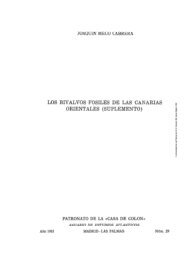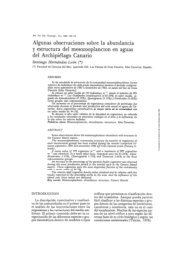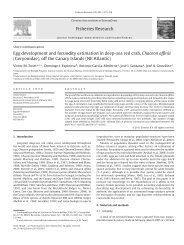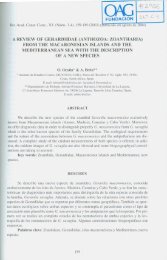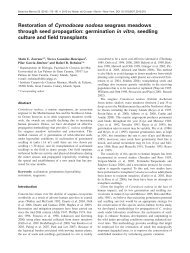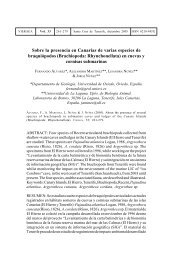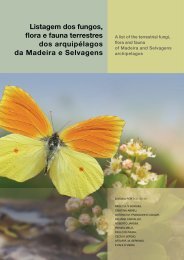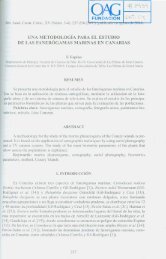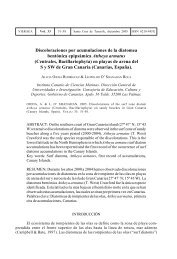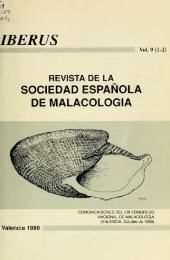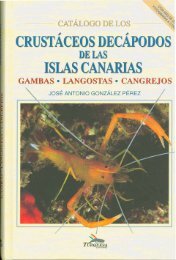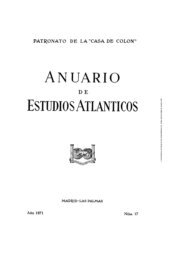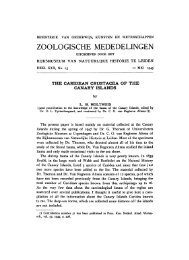fao species catalogue vol. 16. groupers of the world - redmic
fao species catalogue vol. 16. groupers of the world - redmic
fao species catalogue vol. 16. groupers of the world - redmic
You also want an ePaper? Increase the reach of your titles
YUMPU automatically turns print PDFs into web optimized ePapers that Google loves.
click for previous page<br />
Groupers <strong>of</strong> <strong>the</strong> World 25<br />
Geographical Distribution: Red Sea to Mozambique<br />
and east to <strong>the</strong>. Marshall Islands,<br />
Samoa, and <strong>the</strong> Phoenix islands; Japan, Philippines,<br />
Indonesia, Australia, Papua New<br />
Guinea, and probably all <strong>of</strong> <strong>the</strong> islands <strong>of</strong> <strong>the</strong><br />
tropical Indian Ocean (Fig. 47).<br />
Habitat and Biology: Anyperodon is a coralreef<br />
<strong>species</strong> usually found on protected reefs<br />
in depths <strong>of</strong> 5 to 80 m. Adults are primarily<br />
piscivorous. According to Randall and Kuiter<br />
(1989) <strong>the</strong> distinctive blue and gold striped<br />
juveniles are mimics <strong>of</strong> <strong>the</strong> wrasse, Halichoeres<br />
purpurescens (Bloch and Schneider,<br />
1801) and related <strong>species</strong> with a similar colour<br />
pattern. These wrasses feed on micro-inver-<br />
tebrates (much smaller than <strong>the</strong> food <strong>of</strong><br />
Fig. 47 ll<br />
like-sized Anyperodon), and this mimetic association presumably allows Anyperodon (in <strong>the</strong> guise <strong>of</strong> a harmless<br />
wrasse) to approach <strong>the</strong> small fishes and crustaceans on which it feeds.<br />
Size: Maximum total length at least 52 cm.<br />
Interest to Fisheries: Often seen in markets but not plentiful enough to be <strong>of</strong> commercial importance.<br />
Caught with hook-and-line, spear, and probably in traps.<br />
Local Names: KENYA (Swahili): Chewa, Tewa; PAPUA NEW GUINEA: Balala; PALAU: Choloteachl; SEY-<br />
CHELLES: Cheval du bois; SINGAPORE: Kerapu; TANZANIA (Swahili): Chewa, Tewa.<br />
Literature: Morgans (1982); Randall and Ben-Tuvia (1983); Heemstra and Randall (1984,1986); Katayama<br />
(1988); Allen and Steene (1987); Myers (1989); Winterbottom et al. (1989); Randall and Heemstra (1991).<br />
Cephalopholis Bloch and Schneider, 1801 SERRAN Cephal<br />
Cephalopholis Bloch and Schneider, 1801:311; type <strong>species</strong>, Cephalopholis argus Bloch and Schneider, 1801<br />
by monotypy).<br />
Synonyms: Enneacentrus Gill, 1866:105; type <strong>species</strong>, Serranus ouatalibi Valenciennes in Cuv. and Val.,<br />
1828 (=Cephalopholis fulva) by original designation. Petrometopon Gill, 1866:105; type <strong>species</strong>, Serranus<br />
guttatus Poey (a subsequent identification apparently based on Perca guttatus (non Linnaeus): Btoch, 1792<br />
(=Cephalopholis cruentata) by original designation).<br />
Diagnostic Features: Body oblong, robust, not strongly compressed, <strong>the</strong> depth contained 2.0 to 3.2 times<br />
in standard length, <strong>the</strong> body width contained 1.9 to 2.6 times in <strong>the</strong> depth. Head length contained 2.2 to 3.1<br />
times in standard length. Interorbital area flat to slightly convex; snout distinctly longer than eye diameter;<br />
preorbital depth contained 8 to 13 times in head length; preopercle rounded, finely serrate, but without<br />
enlarged serrae at <strong>the</strong> “corner” and no antrorse spines on lower edge; ventral edge <strong>of</strong> interopercle may be<br />
finely serrate posteriorly, but <strong>the</strong>re is no broad indentation; upper edge <strong>of</strong> operculum distinctly convex;<br />
anterior and posterior nostrils subequal; jaws with small canines at <strong>the</strong> front; teeth present on palatines;<br />
maxilla <strong>of</strong> adults with a distinct bony knob on <strong>the</strong> ventroposterior corner; supramaxilla well developed.Dorsal<br />
fin with IX spines and 13 to 17 rays, <strong>the</strong> fin origin over rear part <strong>of</strong> opercle and <strong>the</strong> fin membranes distinctly<br />
incised between <strong>the</strong> spines; no dorsal-fin spines or rays elongated; anal fin with III spines and 7 to 10 rays;<br />
s<strong>of</strong>t dorsal. and anal fins rounded; pectoral fins symmetrically rounded, <strong>the</strong> middle rays longest; caudal fin<br />
rounded or convex posteriorly (truncate in C. polleni), with 8 branched rays and 6 to 9 procurrent rays in<br />
upper part and 7 branched rays and 6 to 9 procurrent rays in lower part. Midlateral-body scales ctenoid.<br />
Supraneural bones 2, <strong>the</strong> posterior one straight or curved posteriorly, much smaller than <strong>the</strong> first one and<br />
situated just anterior to or above tip <strong>of</strong> second neural spine; dorsal fin with <strong>the</strong> last 4 to 7 pterygiophores<br />
trisegmental; anal fin with 3 to 5 trisegmental pterygiophores; rear edge <strong>of</strong> first dorsal-fin pterygiophore<br />
slightly to deeply excavated for tip <strong>of</strong> third neural spine; epipleural ribs on vertebrae 1 to 9 (except C. sonnerati<br />
and C. igarashiensis with epipleurals on vertebrae 1 to 10); cranium distinctly narrowed at interorbital region,<br />
<strong>the</strong> least interorbital width subequal to <strong>the</strong> vomer width and half or less than half <strong>of</strong> <strong>the</strong> width at lateral<br />
ethmoids; frontals separated anteriorly by <strong>the</strong> supraethmoid; no median crest on frontals; medial and lateral<br />
processes <strong>of</strong> epiotics subequal; parasphenoid straight or nearly so.



